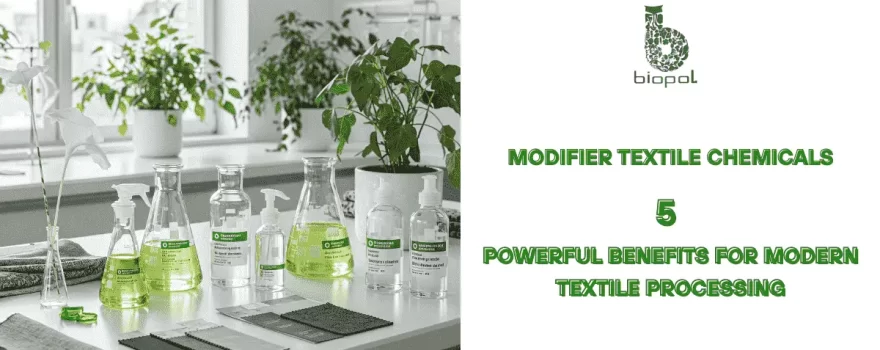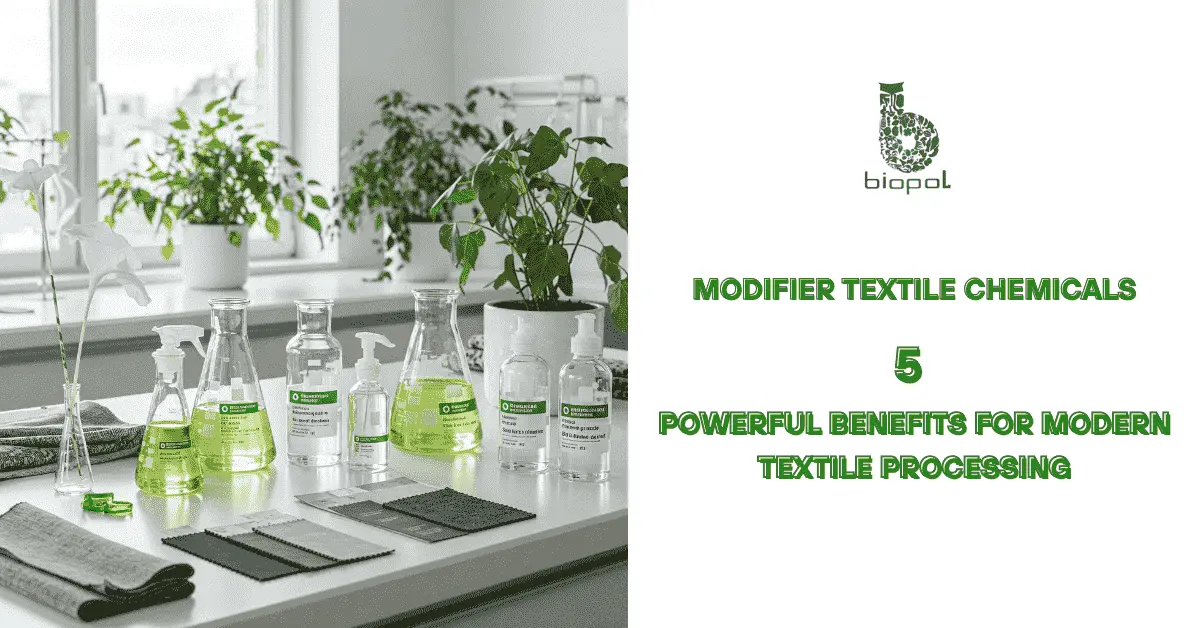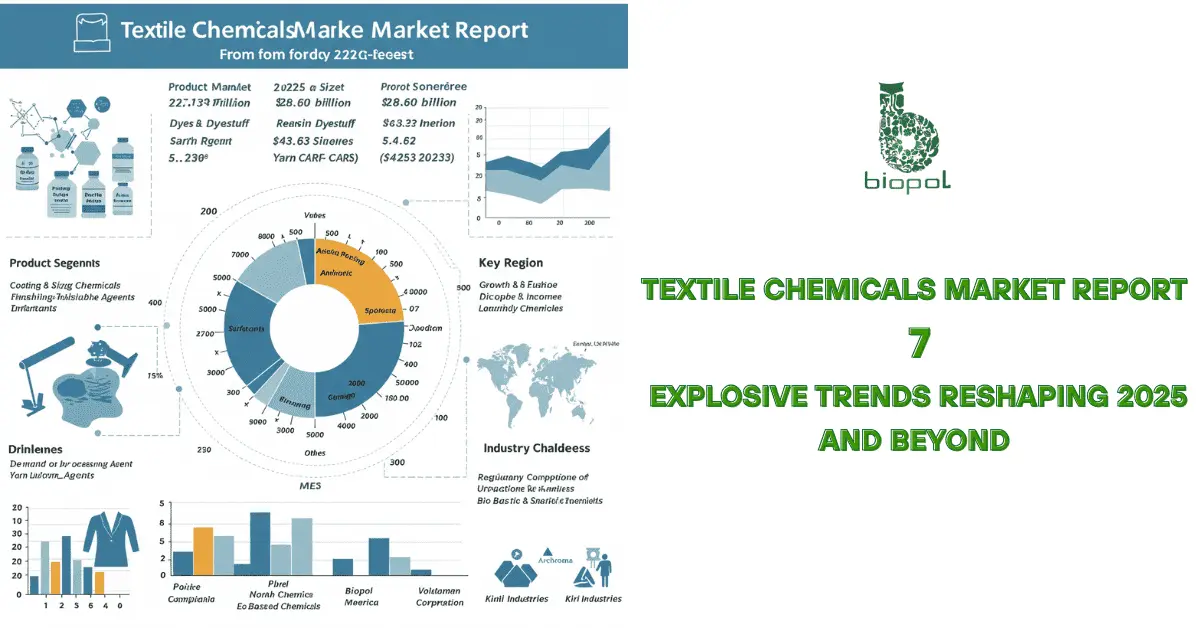
Modifier textile chemicals play a crucial role in enhancing fabric properties, ensuring durability, and improving functionality across various textile applications. This article explores the types, benefits, applications, and trends of these chemicals, offering insights into their significance in modern textile processing and their impact on the industry.
Table of Contents
What Are Modifier Textile Chemicals?
Modifier textile chemicals are additives used to alter the physical or chemical properties of fabrics during processing. They are crucial in pre-treatment, dyeing, and finishing stages, enhancing fabric performance, durability, and appearance.
- Purpose: Improve texture, strength, moisture absorption, and color retention.
- Types:
• Softeners – enhance fabric texture
• Hydrophilic agents – boost moisture absorption
• Anti-static agents – reduce cling
• Cross-linkers – provide crease resistance
• Fixatives – lock in dye
Without these chemicals, fabrics would fall short in both performance and aesthetics.
Main Types of Modifier Chemicals
Modifier textile chemicals fall into distinct categories, each engineered to serve a specific function in fabric enhancement. These chemicals don’t work in isolation—they fine-tune textiles for better performance and feel.
Here are the primary types:
| Modifier Type | Function | Common Use |
| Softeners | Improve fabric hand and drape | Apparel, home textiles |
| Hydrophilic Agents | Increase water absorption | Sportswear, medical fabrics |
| Anti-Static Agents | Reduce electrostatic buildup | Synthetic fabrics, uniforms |
| Cross-Linking Agents | Add crease and shrink resistance | Easy-care garments |
| Fixatives | Enhance dye fixation | Reactive-dyed cotton, blends |
| Silicone Modifiers | Boost elasticity and sheen | Stretch fabrics, luxury apparel |
Modifier textile chemicals, when chosen correctly, transform basic fibers into specialized, high-performance materials. Selecting the right type depends on the fabric’s end use and processing method.
How Modifiers Enhance Fabric Properties
Modifier textile chemicals significantly upgrade fabric quality by fine-tuning its feel, strength, stretch, and functional behavior.
Here’s how they elevate textile performance:
- Feel: Softeners and silicone-based modifiers smooth out harsh textures, making fabrics pleasant to touch and wear.
- Strength: Cross-linkers reinforce fiber bonds, improving tensile strength and resistance to wear.
- Stretch: Elastomeric modifiers increase flexibility and shape retention, especially useful in activewear.
- Function: Hydrophilic and anti-static agents enhance moisture management and prevent static buildup.
Fundamentally, modifier textile chemicals serve as the crucial link between unprocessed fibers and the final textile product. They help textiles stay comfortable, durable, and performance-ready—without compromise.
Application Methods in Textile Processing
Modifier chemicals are applied during key stages of textile production. Their effectiveness depends on the application method:
- Pre-Treatment: Softeners and enzymes prepare fibers for further processes.
- Dyeing: Fixatives ensure uniform color uptake and washfastness.
- Finishing: Methods include padding, exhaustion, and spraying to apply modifiers like softeners and cross-linkers.
Each method balances efficiency, cost, and chemical performance. Modifier textile chemicals work best when matched precisely to the fabric type, desired effect, and processing equipment.
Sustainable Modifier Chemicals
Modifier textile chemicals are evolving, and so are the expectations. Sustainability is no longer optional—it’s a mandate. Manufacturers now turn to eco-safe modifiers to meet global compliance standards without compromising performance. What makes a modifier sustainable? It’s more than a green label. Sustainable modifier textile chemicals are:
- Biodegradable – break down naturally without harming ecosystems
- Non-toxic – free from harmful heavy metals, formaldehyde, or APEOs
- Low-VOC – reduce air pollution during application
- Water-efficient – require less rinsing and processing water
Eco-friendly options include:
| Type | Sustainable Feature |
| Bio-based Softeners | Derived from plant oils, non-silicone based |
| Enzymatic Modifiers | Replace harsh chemicals, operate at low temps |
| Non-ionic Fixatives | Free from formaldehyde, safer for skin contact |
| Silicone-Free Agents | Reduce persistent chemical buildup in effluent |
Choosing sustainable modifier textile chemicals isn’t just good ethics—it’s smart business. Regulatory pressure is mounting, and environmentally responsible production builds long-term credibility in both domestic and global markets.
Modifier vs. Auxiliary Chemicals
Modifier textile chemicals and auxiliary chemicals often share the same processing line—but they don’t serve the same purpose. Misclassifying them can lead to inefficient formulations and inconsistent results.
So, what sets them apart?
- Modifier Textile Chemicals actively change the fiber’s inherent properties. They enhance texture, elasticity, absorption, or resilience. The change is functional and often permanent.
- Auxiliary Chemicals assist in the process without altering the final fabric characteristics. They improve workflow—helping dyes disperse, stabilizing pH, or aiding scouring—but vanish after use.
Here’s a quick breakdown:
| Category | Primary Role | Impact on Fabric |
| Modifiers | Improve or alter fabric performance traits | Lasting and functional |
| Auxiliaries | Support chemical reactions or processing steps | Temporary and process-based |
In summary, modifier textile chemicals shape the fabric’s final identity, while auxiliaries merely guide it through production. Mixing up the two? That’s a shortcut to compromised results.
Industry Use Cases and End-Products
Modifier textile chemicals are versatile, finding their way into a wide range of applications across various textile sectors. From everyday garments to high-tech fabrics, their role is indispensable in delivering performance and functionality.
Here’s how they are used in different industries:
- Garments:
Modifiers such as softeners, anti-static agents, and cross-linkers are common in apparel manufacturing. Softened fabrics feel better on the skin, while anti-static agents ensure garments don’t cling. Cross-linkers ensure easy-care properties like wrinkle resistance. - Home Textiles:
Modifier chemicals are widely used in bed linens, towels, and upholstery. Hydrophilic agents are added to enhance moisture absorption, making towels more effective. Fixatives are often used in home textiles to keep colors vibrant after frequent washes. - Technical Textiles:
In this sector, modifier chemicals are used for more specialized functions. In automotive fabrics, silicone-based modifiers improve durability and elasticity. For medical textiles, hydrophilic modifiers aid in moisture management, improving patient comfort in garments like hospital gowns or wound dressings.
From enhancing comfort to boosting durability and functionality, modifier textile chemicals enable fabrics to perform at their best across diverse applications.
Buying Guide for Modifier Chemicals
Selecting quality modifier textile chemicals involves balancing performance, cost, and sustainability. Here’s a streamlined approach:
- Fabric Compatibility:
Choose chemicals that match the fiber type for optimal results. - Performance & Durability:
Ensure the modifier improves fabric properties and lasts through multiple washes. - Eco-friendliness:
Opt for biodegradable, non-toxic, and low-VOC chemicals to meet environmental standards. - Cost-Effectiveness:
Consider long-term value over initial cost—better performance often reduces waste and reapplications. - Supplier Reputation:
Purchase from trusted vendors known for consistency and quality assurance.
By focusing on these criteria, manufacturers can select modifiers that offer both quality and cost-efficiency.
Market Trends and Global Demand
The modifier textile chemicals market is poised for significant growth, driven by key factors:
- · Sustainability: Demand for eco-friendly options.
- · Innovation: Advancements in processing technologies.
- · Regulatory Pressures: Stricter standards encourage compliance.
- · Consumer Preferences: High demand for sustainable and high-performance textiles.
Outlook:
The market is projected to grow at a 4.5% CAGR from 2024 to 2030, with Asia-Pacific expected to be the fastest-growing region due to expanding textile production. Looking for insights into high-performance textile applications? Don’t miss our article on technical textile chemicals and their role in advanced manufacturing.
In summary, the market is set for sustained growth, driven by sustainability, innovation, and evolving consumer needs.
Choosing Reliable Suppliers
Selecting the right supplier for modifier textile chemicals is crucial for ensuring consistent product quality and supply chain efficiency. Here’s how to make an informed decision:
- Verified Credentials:
Choose suppliers with certifications, such as ISO or other industry-recognized standards, to ensure compliance with safety, quality, and environmental regulations. - Consistency in Quality:
Partner with vendors known for delivering consistent products. Regular product testing and customer feedback can confirm their reliability. - Customer Support:
A supplier that offers excellent after-sales service, including technical support and quick resolution of issues, adds significant value. - Sustainability Commitment:
Opt for suppliers who focus on sustainable practices and offer eco-friendly chemicals, aligning with current industry trends. - Reputation and Track Record:
Choose well-established suppliers with a proven track record in the textile industry. Positive reviews and long-term relationships with clients are indicators of reliability.
In conclusion, a reliable supplier ensures the consistent quality and timely delivery of modifier textile chemicals, contributing to efficient production and product quality.
FAQs
What chemicals are used in textiles?
The textile industry uses various chemicals such as detergents, bleaching agents (like hydrogen peroxide), softeners, water repellents (e.g., fluorocarbons), flame retardants, antibacterial agents, and cross-linking agents to improve the properties of fabrics.
What are the chemicals used in dyeing?
Dyeing involves the use of chemicals like dyes (reactive, acid, and disperse dyes), fixatives, leveling agents, salt, pH adjusters, and reducing agents to ensure uniform color uptake and colorfastness.
What are the chemical products of the textile industry?
Chemical products in the textile industry include textile finishing agents, auxiliaries (such as surfactants), sizing agents, antimicrobial agents, coating materials, and softeners, which all enhance fabric performance and appearance.
What are the solvents used in the textile industry?
Solvents commonly used in the textile industry include water, acetone, toluene, ethanol, xylene, naphtha, and dimethylformamide (DMF), which help in cleaning, dyeing, and other fabric treatments.

